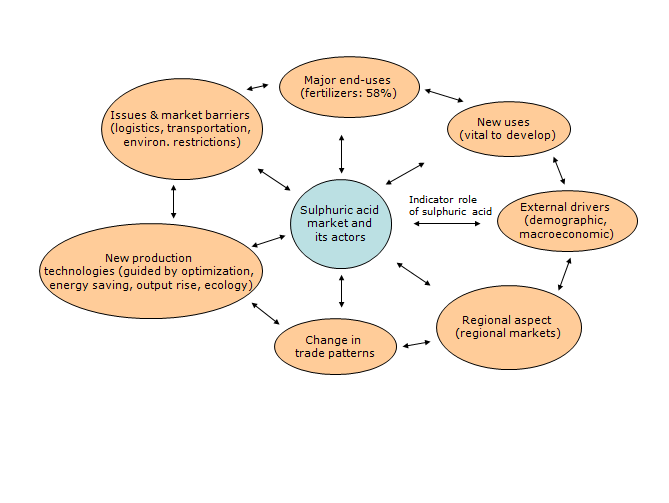Sulfuric acid is one of the most fundamental chemical building blocks serving as a keystone for many modern industries and branches of economy. Its market is a complex system, thus requiring the use of the systems thinking approach in order to grasp its trends. The concept of a system in marketing is not new, as it first emerged in 1934, when Ralph F. Breyer acknowledged that reductionistic approaches to marketing must be integrated with holistic approaches (McHugh and Domegan, 2013). A system is a perceived whole whose elements ‘hang together’ because they continually affect each other over time and operate toward a common purpose, as is based on its original meaning from the Greek verb synistanai, which meant ‘to cause to stand together’ (Senge et al, 1994). As this origin suggests, the structure of a system involves such notions as system elements, inputs/outputs, boundary, environment, interaction of elements, system control, functions and purpose. Thus, it is considered interesting to look at the sulphuric market via the prism of the systems approach by analyzing some of its elements, their interrelations and surrounding environment. It is not possible here to analyze each and every system element and their interrelations but some of them are helpful in understanding future trends of the sulphuric acid market.
Existence of multiple feedback loops in the sulphuric acid market system

According to Caldentey and Mondschein (2003), transportation costs are a crucial factor in the sulphuric acid market. For example, they give an example of a sulphuric acid shipment from Japan to Chile when transportation costs were higher than the commodity price itself (US$50 per metric ton as sulphuric acid price vs. over US$55 per metric ton in transportation costs in 2003). As a result of the new environmental regulations on emissions of sulphur dioxide into the air, the production of sulphuric acid in copper smelters is growing significantly, while this supply growth arising from copper production has become a significant problem for the smelters, due to the need to sell sulphuric acid with its high transportation and handling costs, preferably in regional markets (Caldentey and Mondschein, 2003), which, on par with other reasons (via other system elements, like, for example, the weak demand for sulphuric acid in 2013 from phosphates producers who are major sulphuric acid consumers), also causes oversaturation of global and regional sulphuric acid markets. This near-smelter production practice leads to the change in sulphuric acid trade patterns when surplus by-product sulphuric acid production at smelters might be not at the close proximity to acid consumers, which in turn negatively affects the sulphuric acid market due to higher transportation costs.
Thus, any transportation and logistical issues (for example, the recent shortage of tank vessels for transporting sulphuric acid in Russia) are detrimental for further sulphuric acid market development. This is just an example of how the interplay of various system elements, i.e. new production technologies, stricter environmental regulations, change in trade patterns and regional aspects, and the existence of multiple feedback loops in the sulphuric acid market system might act as factors affecting future sulphuric acid market behaviours.
More information on the sulphuric acid market can be found in the research report “Sulfuric Acid: 2015 World Market Outlook and Forecast up to 2019”.
